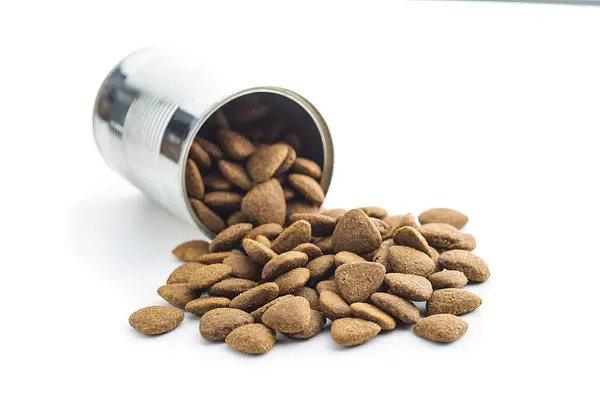Als neuer Welpenbesitzer müssen Sie die Wahl des richtigen Futters und die Bestimmung der richtigen Portionsgröße für Ihren heranwachsenden Fellknäuel treffen. Trockenfutter ist bei vielen Hundebesitzern eine beliebte Wahl, aber die richtige Futtermenge zu finden, kann ein kleines Rätsel sein. Keine Angst! Wir helfen Ihnen, den Trockenfutter-Code zu knacken und sicherzustellen, dass Ihr Welpe die Nährstoffe bekommt, die er zum Gedeihen braucht.
Faktoren, die die Trockenfutterportionen beeinflussen
Bei der Bestimmung der Trockenfuttermenge für Ihren Welpen spielen mehrere Faktoren eine Rolle:
- Alter: Welpen haben in verschiedenen Entwicklungsstadien unterschiedliche Ernährungsbedürfnisse.
- Rassengröße: Welpen großer Rassen haben andere Anforderungen als Welpen kleiner Rassen.
- Aktivitätsniveau: Aktivere Welpen benötigen möglicherweise mehr Kalorien für ihre Abenteuer.
- Körperzustand: Überwachen Sie das Gewicht Ihres Welpen und passen Sie die Portionen entsprechend an.
Den Fütterungsleitfaden konsultieren
Die meisten hochwertigen Marken für Welpenfutter bieten Fütterungsempfehlungen auf ihrer Verpackung oder Website an. Diese Empfehlungen enthalten in der Regel empfohlene Tagesmengen basierend auf dem Alter Ihres Welpen und dem erwarteten Gewicht als ausgewachsener Hund. Beginnen Sie mit diesen Richtlinien, aber denken Sie daran, dass sie nur ein Ausgangspunkt sind.
Überwachung des Körperzustands
Um festzustellen, ob Sie die richtige Menge Trockenfutter füttern, sollten Sie am besten den Körperzustand Ihres Welpen beobachten. Sie sollten die Rippen leicht spüren können, sie sollten jedoch nicht sichtbar sein. Von oben betrachtet sollte Ihr Welpe eine ausgeprägte Taille und von der Seite betrachtet einen eingezogenen Bauch haben. Wenn Ihr Welpe etwas zu mollig oder zu dünn aussieht, passen Sie die Portionen entsprechend an.
Mahlzeiten aufteilen
Welpen haben kleinere Mägen als erwachsene Hunde, daher ist es am besten, die tägliche Portion Trockenfutter auf mehrere Mahlzeiten aufzuteilen. Wenn Ihr Welpe beispielsweise 1 Tasse Trockenfutter pro Tag benötigt, können Sie ihm dreimal täglich 1/3 Tasse anbieten. Wenn Ihr Welpe wächst, können Sie die Anzahl der Mahlzeiten allmählich verringern und die Portionsgrößen erhöhen.
Nach Bedarf anpassen
Welpen wachsen unterschiedlich schnell und ihre Nährstoffbedürfnisse können sich mit der Zeit ändern. Behalten Sie die körperliche Verfassung und das Energieniveau Ihres Welpen genau im Auge und zögern Sie nicht, die Trockenfutterportionen bei Bedarf anzupassen. Wenn Sie Bedenken hinsichtlich des Wachstums oder der Ernährung Ihres Welpen haben, wenden Sie sich für eine individuelle Beratung an Ihren Tierarzt.
Bonus-Tipp: Nutzen Sie die Doggy Time App
Um die Trockenfutterportionen und den Fütterungsplan Ihres Welpen ganz einfach zu verfolgen, sollten Sie die App „Doggy Time“ verwenden. Mit diesem praktischen Tool können Sie die Mahlzeiten Ihres Welpen protokollieren, sein Wachstum überwachen und bei der Pflege mit Familienmitgliedern zusammenarbeiten. Mit intelligenten Alarmen und Planungsfunktionen können Sie sicherstellen, dass Ihr Welpe nie eine Mahlzeit verpasst und seinen Nährstoffbedarf im Auge behält.
Denken Sie daran, dass jeder Welpe einzigartig ist und was bei dem einen funktioniert, muss bei dem anderen nicht funktionieren. Seien Sie geduldig und aufmerksam und stellen Sie die Gesundheit und das Wohlbefinden Ihres Welpen immer an erste Stelle. Mit einer ausgewogenen Ernährung und viel Liebe wird Ihr Fellknäuel zu einem glücklichen, gesunden erwachsenen Hund heranwachsen.






